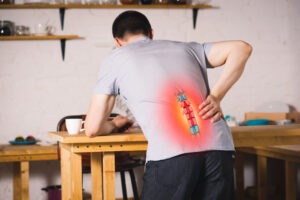
Are you suffering from a herniated disc due to an accident caused by someone else’s negligence? From car crashes and workplace incidents to slip and fall cases and more, accidents that cause herniated discs can leave victims in a lot of pain.
If you’re facing challenges caused by an injury of this nature, consider reaching out to a Fort Myers personal injury lawyer at the law firm of Viles & Beckman. We have more than 40 years of combined experience.
In that time, we have recovered over $100 million in compensation for people in situations just like yours. As your Fort Myers herniated disc lawyer, we can look into the details of your case and determine if you are eligible for compensation.
Common Symptoms of a Herniated Disc
Did you know that the human spine consists of a series of bones called vertebrae? They are separated by soft, gel-filled discs that provide cushion, protect the bones, and allow for flexibility.
With this in mind, it may be easier to understand how a herniated disc occurs. It takes place when the outer layer of your spinal disc tears, which causes the gel-like center to protrude. Also known as a slipped or ruptured disc, it can compress nearby nerves and cause discomfort.
Here are examples of other side effects you might endure as a result of a herniated disc:
- Severe pain in the back, neck, arms, or legs
- Numbness or tingling in your extremities
- Muscle weakness and a limited range of motion
- Difficulty standing, walking, or sitting for long periods
When you reach out to Viles & Beckman, you can expect a client-focused and results-driven approach. After all, our mission & values include putting the rights of victims like you first and foremost. We make it a priority to pursue the compensation you deserve.



Expect More, Receive More: Legal Support That Feels Like Family
Common Causes of Herniated Discs
Herniated discs are often the result of unexpected incidents or repetitive strain placed on the spine. These injuries can arise from many situations, ranging from car accidents to workplace mishaps and more.
Identifying the cause of a herniated disc is important because your lawyer needs to understand what led to your injuries to determine liability and pursue compensation to the fullest extent. Here are examples of common causes of herniated disc cases:
- Car crashes
- Slip and fall incidents
- Workplace accidents
- Medical malpractice
Statute of Limitations for Herniated Disc Cases in Florida
In Florida, the statute of limitations for personal injury claims is two years from the date of the accident. If you fail to take legal action within this 24-month timeframe, you might be barred from recovering compensation, even when you are the victim of a herniated disc case.
That said, there are certain situations in which the statute of limitations could be shortened or extended. For example, in cases involving government entities—like accidents that take place on public property—additional rules and shorter deadlines may apply.
The only way to know, without a doubt, how long you have is to speak with a personal injury lawyer as soon as possible. Your legal counsel can advise you on what you can expect and ensure that you don’t miss any deadlines.
How a Fort Myers Herniated Disc Lawyer Can Help You
Personal injury claims can be confusing. They can be especially difficult when you are simultaneously trying to manage the pain and stress of your herniated disc. However, you don’t need to figure legal matters out by yourself.
Instead, consider speaking with a Fort Myers herniated disc attorney with experience handling cases like yours. When you retain a lawyer, your attorney can tackle the legal side of things while you focus on healing and prioritizing your recovery—both mentally and physically.
Here’s what legal counsel can do for you:
- Investigate the accident
- Gather evidence regarding your case
- Establish liability and build a strong case
- Calculate the extent of your damages
- Assess the value of your losses
- Help you pursue maximum compensation
- Negotiate with insurance companies
- Handle communications with the other party
- Counter low or unfair settlement offers
- Represent you in court, if necessary
- Advocate for your rights at all times
Contact Our Fort Myers Herniated Disc Law Firm for More Information Today
If you’ve suffered a herniated disc due to someone else’s negligence, we encourage you to call the law firm of Viles & Beckman. Don’t try to seek justice all by yourself—let the professionals handle the legal side of things so you can focus on healing and recovering.
With a Fort Myers herniated disc attorney by your side, you can rest assured that someone is actively negotiating with insurance providers, advocating for your rights, and pursuing fair compensation on your behalf. We’re here for you, and we get results.
When you call our law firm, you’ll hear more about Viles & Beckman and what we can do for you. We will always work hard for you and give your case the attention it deserves. With us, you can trust that we will treat you as we would our own families.


 (239) 334-3933
(239) 334-3933
 Click To Contact
Click To Contact

